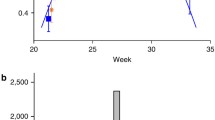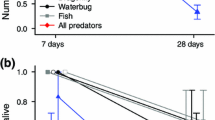Abstract
Environmental constraints can be determinant key factors conditioning predator life history evolution. Prey seems to have conditioned life history evolution in their ladybird predator, with the predators of aphids apparently presenting faster development, greater fecundity and shorter longevity than species preying on coccids. However a rigorous comparison has never been done. We hypothesize that aphids and coccids differ by their developmental rate, abundance, and distribution in the field, which act as ecological constraints promoting life history evolution in ladybird predators. Field data reveal that aphids are ephemeral resources available in the form of large colonies randomly distributed in the habitat whereas coccids form smaller colonies that tend to be aggregated in space and available for longer periods. A comparison in laboratory conditions of two predatory species belonging to the tribe Scymnini (Coleoptera: Coccinellidae) show that the aphidophagous species lives at a faster pace than the coccidophagous: it develops faster, matures earlier, is more fecund, has a shorter reproductive life-span and allocate proportionally more fat in its gonads relative to soma. This indicates that the life histories of aphidophagous and coccidophagous ladybird predators appear to have evolved in response to particular patterns of prey availability in time and space. Under the light of these results, the existence of a slow-fast continuum in ladybirds is briefly addressed.
Similar content being viewed by others
References
Arendt JD, Reznick DN (2005) Evolution of juvenile growth rates in female guppies (Poecilia reticulata): predator regime or resource level? Proc R Soc B Biol Sci 272:333–337
Begon M, Harper JL, Townsend CR (1996) Ecology. Individual, populations and communities. Blackwell, UK
Borges I, Soares AO, Hemptinne J-L (2006) Abundance and spatial distribution of aphids and scales select for different life histories in their ladybird beetle predators. J Appl Entomol 130(8):461–464
Bursell E (1970) An introduction to insect physiology. Academic Press, London
Canepari C (2001) The identity of Nephus levaillanti (Coleoptera Coccinellidae). Boll Soc Entomol Ital 133(3):207–211
Chapman RF (1998) The insects. Structure and function, 4th edn. Cambridge University Press, Cambridge
Crawley MJ, Krebs JR (1992) Foraging theory. In: Crawley MJ (ed) Natural enemies. Blackwell Scientific Publications, Oxford, pp 90–114
Dixon AFG (1998) Aphid ecology. Chapman and Hall, London
Dixon AFG (2000) Insect predator-prey dynamics. Ladybird beetles and biological control. Cambridge University Press, Cambridge
Dixon AFG, Agarwala BK (1999) Ladybird-induced life history changes in aphids. Proc R Soc B Biol Sci 266:1549–1553
Dixon AFG, Hemptinne J-L, Kindlmann P (1997) Effectiveness of ladybirds as biological control agents: patterns and processes. Entomophaga 42:71–83
Dixon AFG, Honěk A, Keil P, Kotela MAA, Šizling A, Jarošík V (2009) Relationship between the minimum temperature thresholds for development in insects. Funct Ecol 23:257–264
Dobson FS (2007) A lifestyle view of life-history evolution. Proc Natl Acad Sci USA 104:17565–17566
Evans EW (2003) Searching and reproductive behavior of female aphidophagous ladybirds (Coleoptera: Coccinellidae): a review. Eur J Entomol 100:1–10
Fisk DL, Latta LC, Knapp RA, Pfrender ME (2007) Rapid evolution in response to introduced predators I: rates and patterns of morphological and life-history trait divergence. BMC Evol Biol 7:22
Franco M, Silvertown J (1996) Life history variation in plants: an exploration of the fast-slow continuum hypothesis. Philos Trans R Soc B 1345(351):1341–1348
Giorgi JA, Vandenberg NJ, McHugh JV, Forrester JA, Ślipiński SA, Miller KB, Shapiro LR, Whiting MF (2009) The evolution of food preferences in Coccinellidae. Biol Control 51:215–231
Harvey PH, Read AF, Promislow DEL (1989) Life history variation in placental mammals: unifying the data with theory. Oxford Surv Evol Biol 6:13–31
Hemptinne J-L, Dixon AFG, Coffin J (1992) Attack strategy of ladybird beetles (Coccinellidae): factors shaping their numerical response. Oecologia 90:238–245
Herz A, Heitland W (2002) Comparison of the fat allocation patterns in female pine sawflies (Hymenoptera: Diprionidae). Eur J Entomol 99:117–120
Hodek I, Honĕk A (1996) Ecology of Coccinellidae. Kluwer Academic Publishers, Dordrecht
Iwao S (1968) A new regression method for analyzing the aggregation pattern of animal populations. Res Pop Ecol 10:1–20
Izhevsky SS, Orlinsky AD (1988) Life history of the imported Scymnus (Nephus) reunioni (Col.: Coccinellidae) predator of mealybugs. Entomophaga 33:101–114
Kindlmann P, Dixon AFG (1993) Optimal foraging in ladybird beetles (Coleoptera: Coccinellidae) and its consequences for their use in biological control. Eur J Entomol 90:443–450
Kontodimas DC, Eliopoulos PA, Stathas GJ, Economou LP (2004) Comparative temperature-dependent development of Nephus includens (Kirsch) and Nephus bisignatus (Boheman) (Coleoptera: Coccinellidae) preying on Planococcus citri (Risso) (Homoptera: Pseudococcidae): evaluation of linear and various nonlinear models using specific criteria. Environ Entomol 33:1–11
Latta LC, Bakelar JW, Knapp RA, Pfrender ME (2007) Rapid evolution in response to introduced predators II: the contribution of adaptative plasticity. BMC Evol Biol 7:21
Lloyd M (1967) Mean crowding. J Anim Ecol 36:1–30
M’Hamed BT, Chemseddine M (2001) Assessment of temperature effects on the development and fecundity of Pullus mediterraneus (Col., Coccinellidae) and consumption of Saissetia oleae eggs (Hom., Coccoidea). J Appl Entomol 125:527–531
Magro A, Hemptinne J-L, Navarre A, Dixon AFG (2003) Comparison of the reproductive investment in coccidophagous and aphidophagous ladybirds (Coleoptera, Coccinellidae). In: Soares AO, Ventura MA, Garcia V, Hemptinne J-L (eds) Proceedings of the 8th international symposium on ecology of aphidophaga: biology, ecology and behaviour of aphidophagous insects. Arquipélago. Life and Marine Sciences, Universidade dos Açores, Ponta Delgada, pp 29–31
Magro A, Lecompte E, Magné F, Hemptinne J-L, Crouau-Roy B (2010) Phylogeny of ladybirds (Coleoptera: Coccinellidae): are the subfamilies monophyletic? Mol Phylogenet Evol 54:833–848
Majerus MEN, Kearns P (1989) Ladybirds. Naturalists’ handbook 10. Richmond Publishing Company, Slough
Partridge L, Harvey PH (1988) The ecological context of life history evolution. Science 241:1449–1455
Partridge L, Sibly R (1991) Constraints in the evolution of life histories. Philos Trans R Soc B 332:3–13
Persad A, Khan A (2002) Comparison of life table parameters for Maconellicoccus hirsutus, Anagyrus camali, Cryptolaemus montrouzieri and Scymnus coccivora. Biocontrol 47:137–149
Reznick D, Bryga H, Endler JA (1990) Experimentally induced life-history evolution in a natural population. Nature 346:357–359
Reznick D, Bryant M, Holmes D (2006) The evolution of senescence and post-reproductive lifespan in guppies (Poecilia reticulata). PLoS Biol 4(1):e7
Rochet M-J, Cornillon P-A, Sabatier R, Pontier D (2000) Comparative analysis of phylogenetic and fishing effects in life history patterns of teleost fishes. Oikos 91:255–270
Roff DA (2002) Life history evolution. Sinauer Associates Inc., Sunderland
Sengonca C, Arnold C (2003) Development, predation and reproduction by Exochomus quadripustulatus L. (Coleoptera: Coccinellidae) as predator of Pulvinaria regalis Canard (Homoptera: Coccidae) and its coincidence with the prey in the field. J Plant Dis Protect 110:250–262
Sibly RM, Brown JH (2007) Effects of body size and lifestyle on evolution of mammals life histories. Proc Natl Acad Sci USA 104:17707–17712
Silva L, Moura M, Schaefer H, Rumsey F, Dias EF (2010) List of vascular plants (Tracheobionta). In: Borges PAV, Costa A, Cunha R, Gabriel R, Gonçalves V, Martins AF, Melo I, Parente M, Raposeiro P, Rodrigues P, Santos RS, Silva L, Vieira P, Vieira V (eds) A list of the terrestrial and marine biota from the Azores. Princípia, Cascais, pp 117–146
Southwood TRE, Henderson PA (2000) Ecological methods. Blackwell Science Ltd., Oxford
SPSS (2001) Base Version 11.5 SPSS Inc., Chicago
Stearns SC (2000) Life history evolution: successes, limitations, and prospects. Naturwissenschaften 87:476–486
Stearns SC (2004) The evolution of life histories. Oxford University Press Inc., New York
Uygun N, Atlihan R (2000) The effect of temperature on development and fecundity of Scymnus levaillanti. Biocontrol 45:453–462
Wheeler D (1996) The role of nourishment in oogenesis. Annu Rev Entomol 41:407–431
Wiersma P, Muñoz-Garcia A, Walker A, Williams JB (2007) Tropical birds have a slow pace of life. Proc Natl Acad Sci USA 22(104):9340–9345
Zar JH (1996) Biostatistical analysis. Prentice-Hall, New Jersey
Acknowledgments
I. B. was funded by a PhD grant (POCI 2010 and FSE) and by Programa Pessoa 2007/2008 France. A. O. S. was funded by Programa Pessoa 2007/2008 France. J.-L. H. was funded by a grant from the French Ministry of Foreign Affairs (EGIDE/Project Pessoa PAI 2007/2008 # 14714PG). The authors express their gratitude to Roberto Resendes for helping in the field work, to Rafael Arruda for assistance in the laboratory work, to Luis Silva for identifying plant host species, to J. A. Ilharco for aphid species identification, to Felipe Rámon-Portugal for assistance in fat content determination, and to Serviços Agrários for growing maize. Thanks are also due to Serviços Florestais de Ponta Delgada for allowing access to the study area. We thank J. P. Michaud for constructive comments on an earlier version of the manuscript and for improving the English.
Author information
Authors and Affiliations
Corresponding author
Rights and permissions
About this article
Cite this article
Borges, I., Soares, A.O., Magro, A. et al. Prey availability in time and space is a driving force in life history evolution of predatory insects. Evol Ecol 25, 1307–1319 (2011). https://doi.org/10.1007/s10682-011-9481-y
Received:
Accepted:
Published:
Issue Date:
DOI: https://doi.org/10.1007/s10682-011-9481-y




